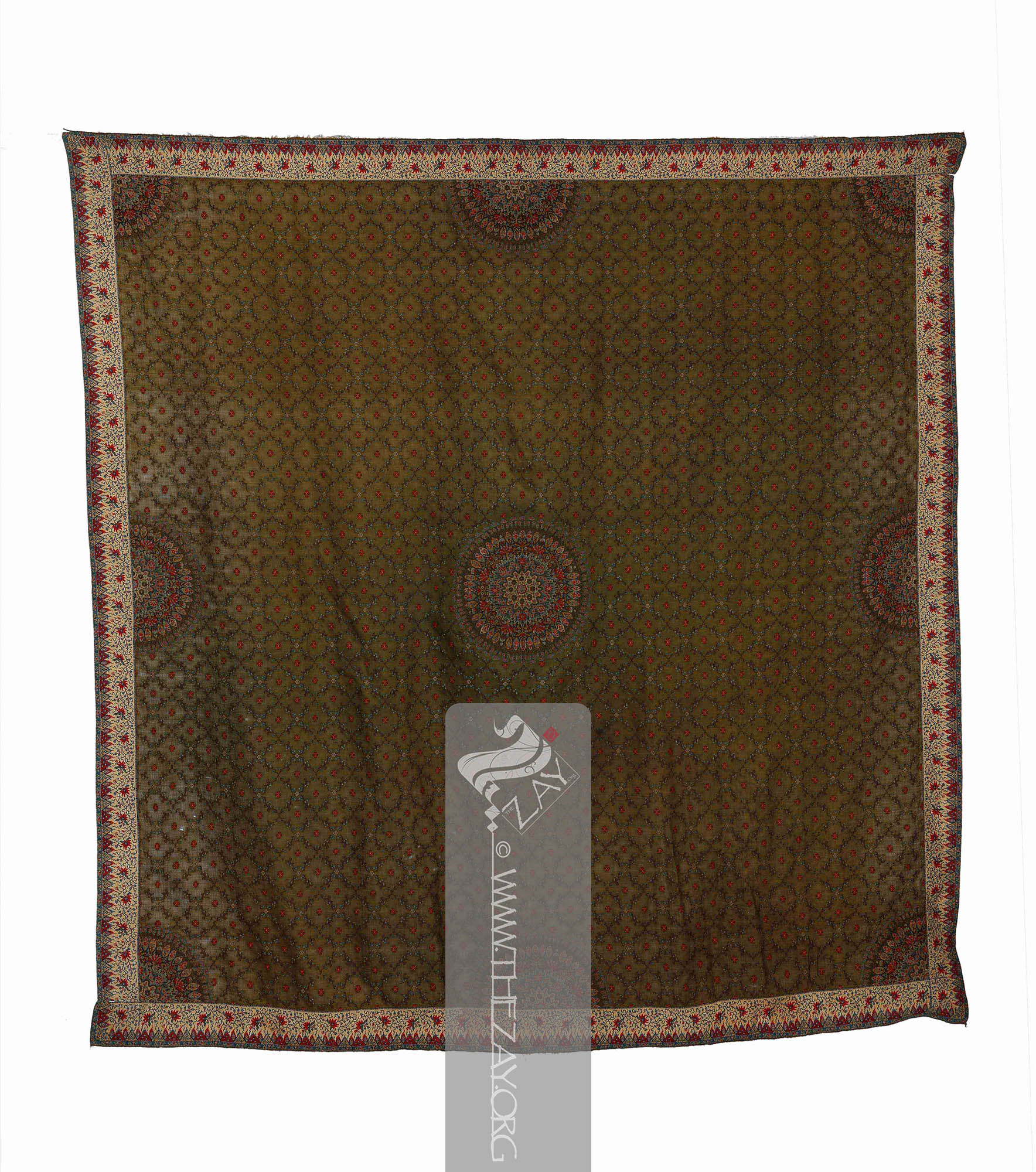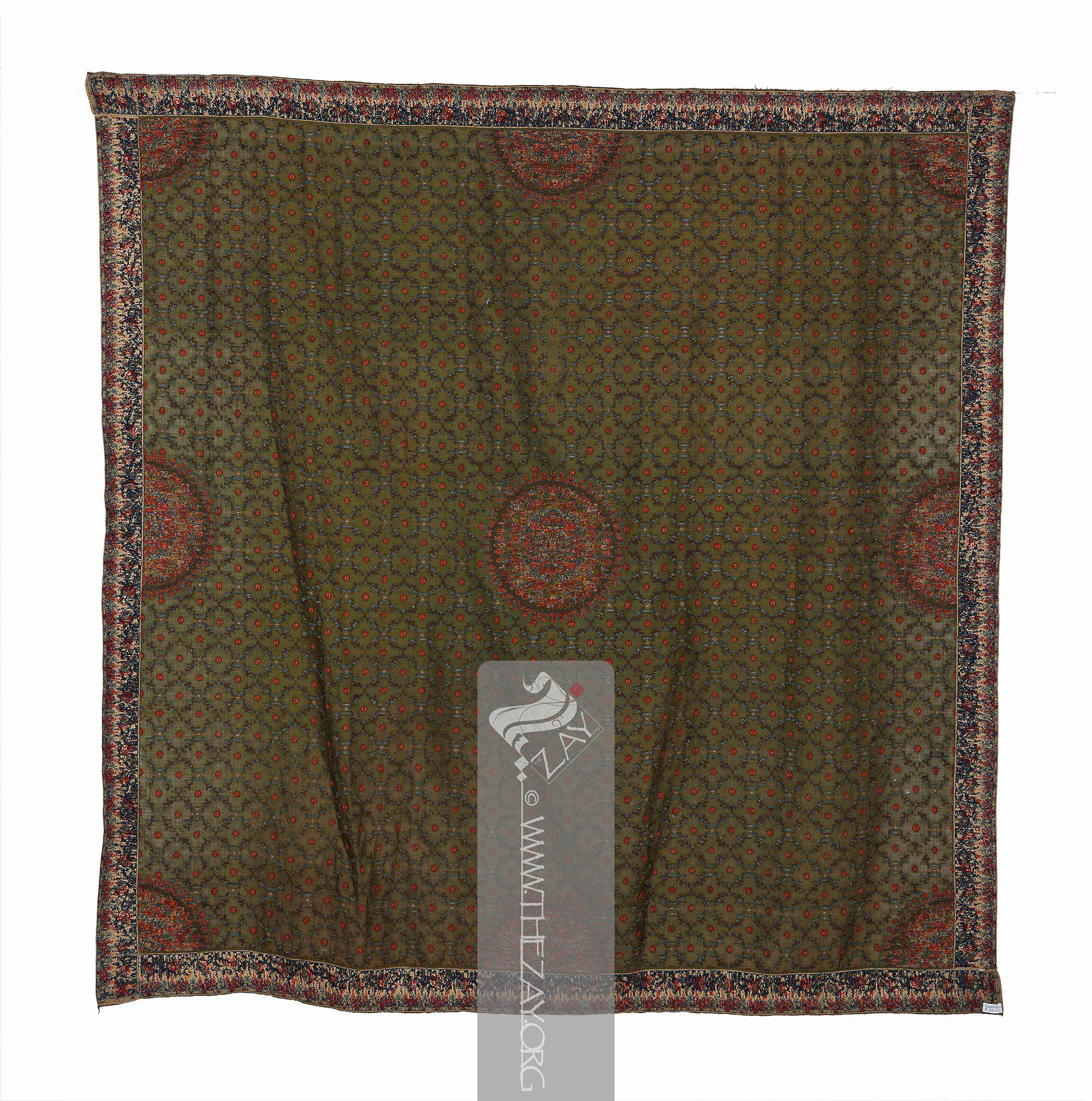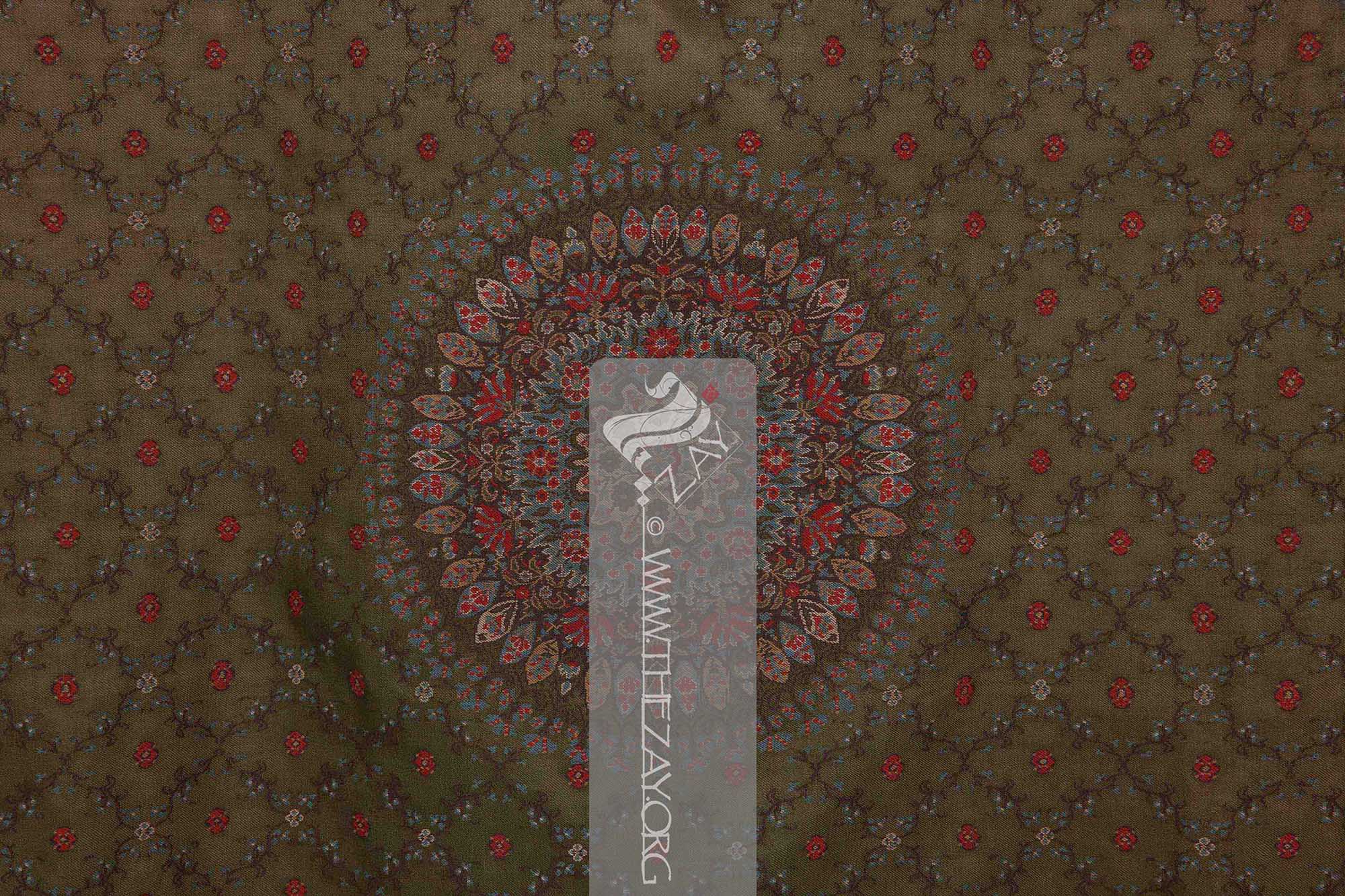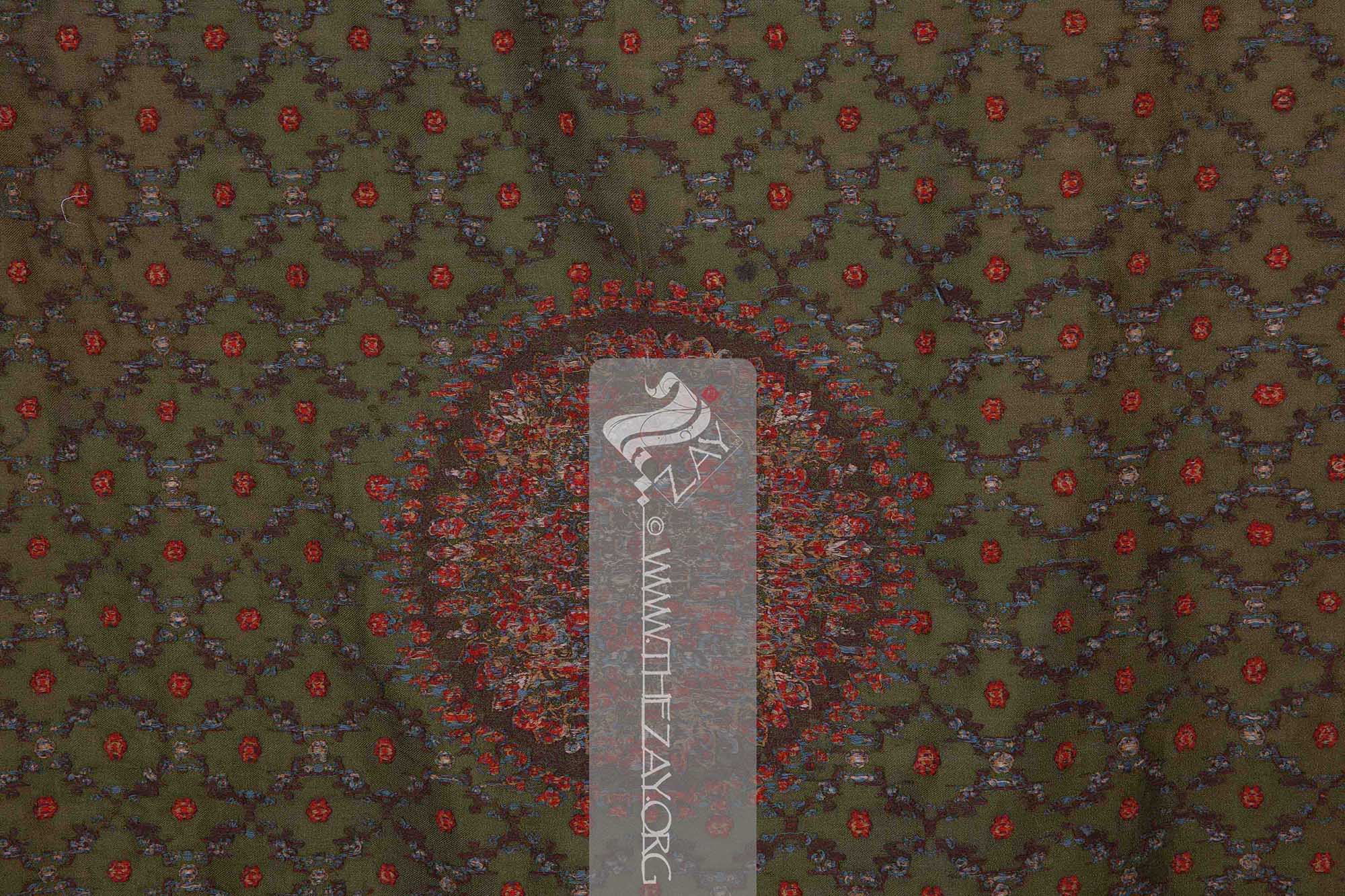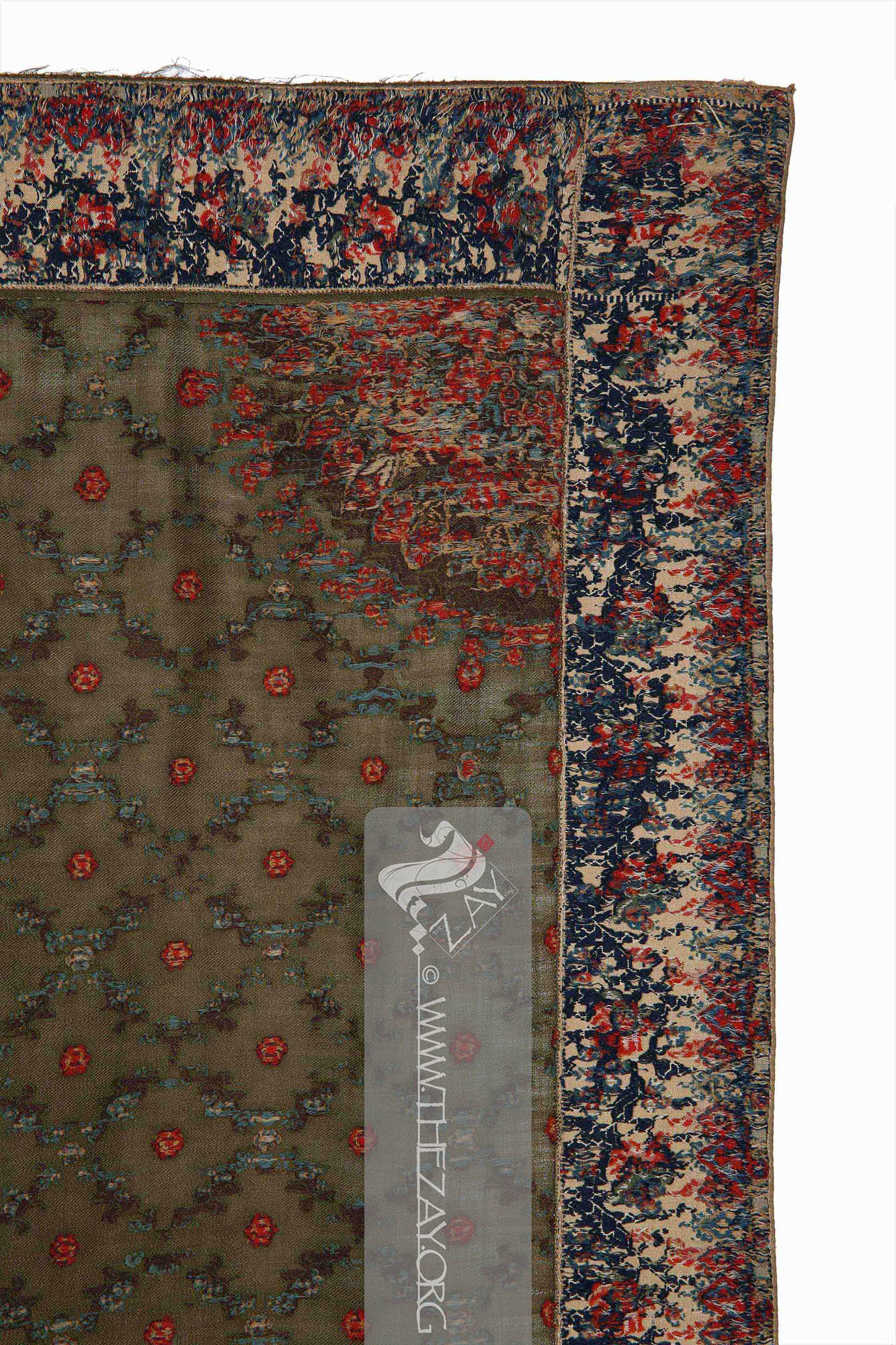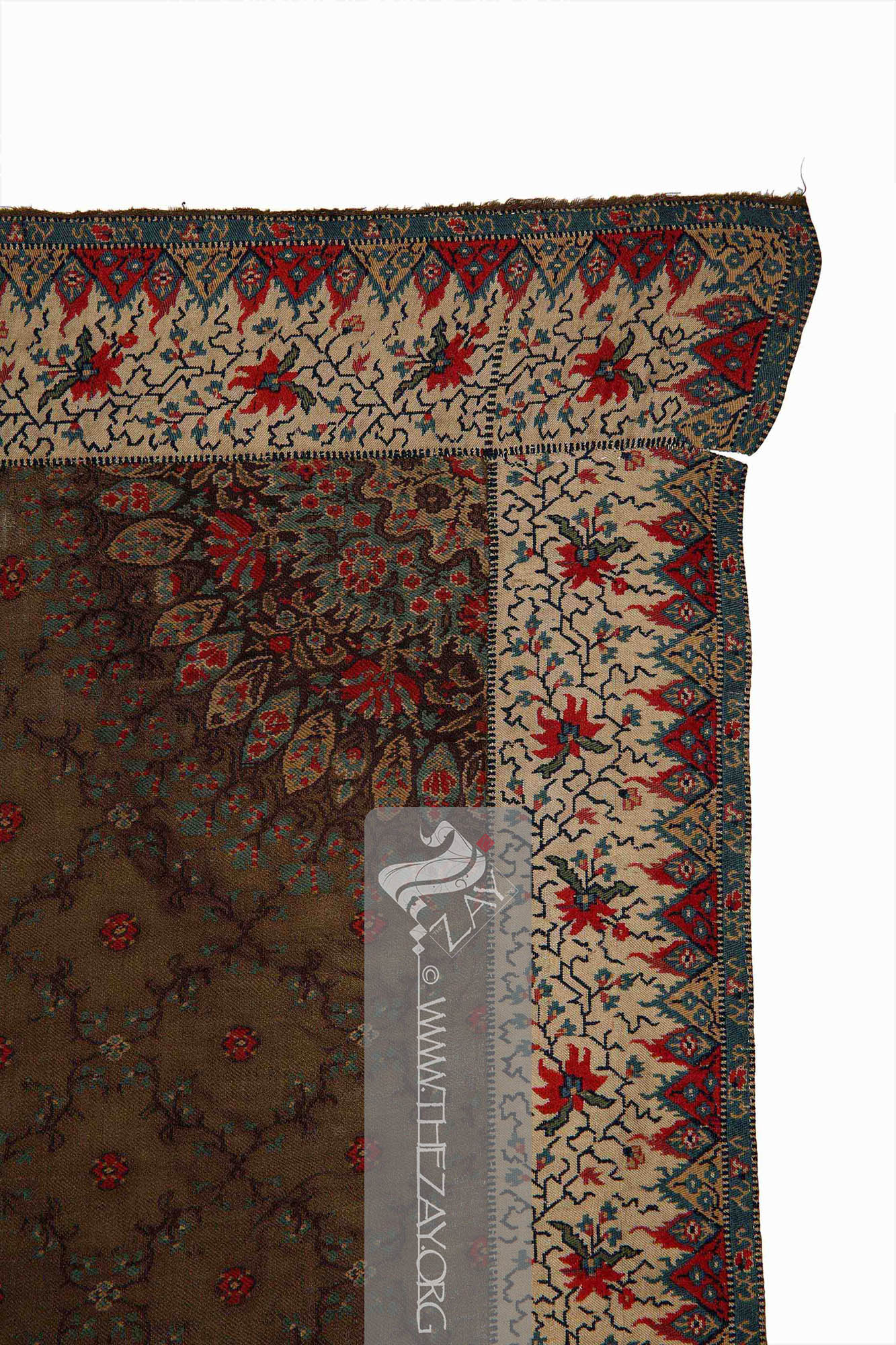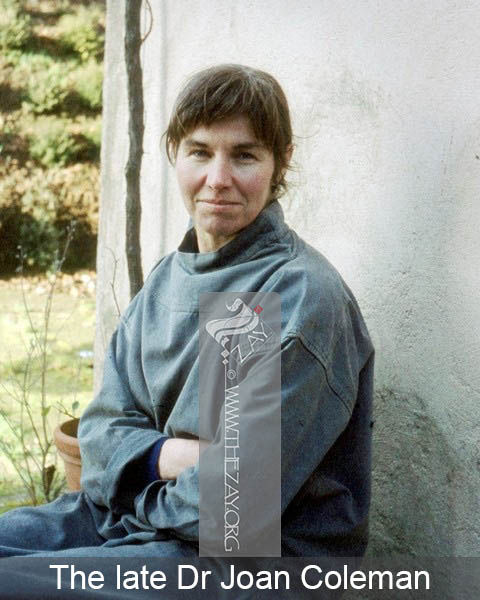Object HistoryThis silk (
moon_shawl
Moon_shawl: (Synonym: chandar), was originally luxurious hand-woven shawl
Shawl: (Persian: shāl from Hindi: duśālā – Shoulder Mantle), a shawl is a South Asian version of a scarf worn or wrapped loosely over the shoulders and is usually made of wool. that originated in 17th century Kashmir and was characterized by a central circular medallion in an otherwise plain square field with four quarter medallions one in each corner. ) dating back to the early 19th century was originally a part of the Dr Joan Coleman Collection. The
Zay
Zay: (Arabic: costume, Pl. azyaā’), a set of clothes in a style typical of a particular country or historical period. Initiative managed to acquire it from Kerry Taylor Auctions in 2020.
Dr Joan Coleman began collecting shawls in 1976 and developed her lifelong passion for collecting. She was a regular at the London salesrooms of Christie’s, Sotheby’s, and Phillips – three of the most outstanding auction houses of the period in the world – getting to know the dealers and learning in the process. She acquired vast knowledge and dedicated hours carefully cataloguing her ever-growing collection. She intended to loan her collection to different museums and institutions for the benefit of learning and education. Her collection is one of the largest and the finest private
shawl
Shawl: (Persian: shāl from Hindi: duśālā – Shoulder Mantle), a shawl is a South Asian version of a scarf worn or wrapped loosely over the shoulders and is usually made of wool. collections to have ever graced the world with shawls ranging from Kashmir,
Paisley
Paisley: (Scottish Gaelic, Pàislig: a town in Scotland), often called buta, boteh, amli, or kalgi in the subcontinent and kazuwah in Arabic, is a Persian tear drop motif with a curved end specially in textiles. Its popularity and subsequent local production in 18th century at Paisley are responsible for its nomenclature., Edinburgh, Norwich, France, and Iran.
Object Features It is a square
shawl
Shawl: (Persian: shāl from Hindi: duśālā – Shoulder Mantle), a shawl is a South Asian version of a scarf worn or wrapped loosely over the shoulders and is usually made of wool. of olive-green silk base with a large central floral medallion, four half circles one on each side, and four small quadrants in the corners. Often identified or categorised as
moon_shawl
Moon_shawl: (Synonym: chandar), was originally luxurious hand-woven shawl
Shawl: (Persian: shāl from Hindi: duśālā – Shoulder Mantle), a shawl is a South Asian version of a scarf worn or wrapped loosely over the shoulders and is usually made of wool. that originated in 17th century Kashmir and was characterized by a central circular medallion in an otherwise plain square field with four quarter medallions one in each corner. this piece was possibly woven on a (
draw_loom
Draw_loom: (English) It is a type of weaving apparatus that enables complex patterns to be woven into textiles. It uses a system of cords and pulleys to control the warp
Warp: One of the two basic components used in weaving which transforms thread or yarns to a piece of fabric. The warp is the set of yarns stretched longitudinally in place on a loom before the weft
Weft: one of the two basic components used in weaving that transforms thread or yarns into a piece of fabric. It is the crosswise thread on a loom that is passed over and under the warp threads. is introduced during the weaving process. threads, allowing individual threads to be lifted and lowered to create intricate designs.) at Norwich sometime between c. 1820-30.
The body of the
shawl
Shawl: (Persian: shāl from Hindi: duśālā – Shoulder Mantle), a shawl is a South Asian version of a scarf worn or wrapped loosely over the shoulders and is usually made of wool. is embellished with a vined trellis design in brown wool that gives the entire
shawl
Shawl: (Persian: shāl from Hindi: duśālā – Shoulder Mantle), a shawl is a South Asian version of a scarf worn or wrapped loosely over the shoulders and is usually made of wool. a (
damask
Dāmāsk: (Arabic: Damascus – a city in Syria), is a luxurious fabric woven with reversible patterns typically in silk, wool, linen, or cotton. Originating in China, the fabric was perhaps introduced to European traders at Damascus – a major trading post on the Silk Road with a thriving local silk industry. ) effect. A scarlet red flower is placed in the middle of each trellis while an ivory flower is placed at the nodes. The centre of the
shawl
Shawl: (Persian: shāl from Hindi: duśālā – Shoulder Mantle), a shawl is a South Asian version of a scarf worn or wrapped loosely over the shoulders and is usually made of wool. is embellished with several tiers of floral arrangements in circular forms primarily in
coral
Coral: (Greek: korallion, probably from Hebrew: goral – small pebbles), is a pale to medium shade of pink with orange or peach undertones, resembling the colour of certain species of coral. pink, (
indigo
Indigo: (Latin: Indigo – India, synonym: nil
Nīl: (Latin: indigo), Arabised term for Indigo, a natural dye belonging to the ‘Indigofera Tinctoria’ species of plants that have been cultivated in East Asia, Egypt, India, and Peru since antiquity. According to Pliny the Elder, it was named after India as it was the source of the dye.), a natural dye belonging to the ‘Indigofera Tinctoria’ species of plants that has been cultivated in East Asia, Egypt, India, and Peru since antiquity. According to Pliny the Elder, it was named after India as it was the source of the dye. ) blue, and beige with (
turquoise
Turquoise: (French: turquois – present day Türkiye; Synonyms: firuze, pheroza), is a naturally occurring opaque mineral mined in abundance in Khorasan province of Iran and has been used for making dye for centuries. The term is a derivative of the French word for the country Türkiye once called Turkey. )/(
pheroza
: (Persian: pērōzah – "victory", later Arabic: fayrūz; Synonyms: firuze, turquoise
Turquoise: (French: turquois – present day Türkiye; Synonyms: firuze, pheroza), is a naturally occurring opaque mineral mined in abundance in Khorasan province of Iran and has been used for making dye for centuries. The term is a derivative of the French word for the country Türkiye once called Turkey. ), is a naturally occurring opaque mineral mined in abundance in Khorasan province of Iran and has been used for making dye for centuries. ) highlights. A similar arrangement in the form of a half circle is repeated on the four sides near the borders. The corners are embellished with similar designs in the form of small quadrants.
The borders – a separately woven piece sewn to the
shawl
Shawl: (Persian: shāl from Hindi: duśālā – Shoulder Mantle), a shawl is a South Asian version of a scarf worn or wrapped loosely over the shoulders and is usually made of wool. by means of machine stitches – are woven on a beige base with branches in black arranged in zigzag patterns and are punctuated with stylized carnations and flame-like motifs.
Also called a (
chandar
Chāndar: (Hindustani: chānd – moon; dar – derivative of chadar – a mantle or a covering; Synonym: Moon_shawl
Shawl: (Persian: shāl from Hindi: duśālā – Shoulder Mantle), a shawl is a South Asian version of a scarf worn or wrapped loosely over the shoulders and is usually made of wool. ), were originally luxurious hand-woven shawls that originated in 17th century Kashmir and were characterized by a central circular medallion in an otherwise plain square field with four quarter medallions one in each corner. )
Kashmiri
Kashmiri: (Hindustani: Kashmir – a region in South Asia), a term used to denote or identify anything related to the region – its people, their language, culture, art and craft, society etc. moon_shawl
Moon_shawl: (Synonym: chandar), was originally luxurious hand-woven shawl
Shawl: (Persian: shāl from Hindi: duśālā – Shoulder Mantle), a shawl is a South Asian version of a scarf worn or wrapped loosely over the shoulders and is usually made of wool. that originated in 17th century Kashmir and was characterized by a central circular medallion in an otherwise plain square field with four quarter medallions one in each corner. was originally (
jamawar
Jamawar: (Hindi, Jama: robe and war/var: chest or body), a portmanteau word meaning anything that covers the body. Originally brocade silk of intricate and overlapping patterns first introduced by the traders from Samarkand and Bukhara to the subcontinent and was adopted in wool specifically in pashmina
Pāshmīna: (Persian: pašm or pashm – wool), pashmina scarves are eponymous woolen shawls from the Kashmir region with a history dating back to more than 500 years. It is the finest variant of spun cashmere wool extracted from the downy undercoat of the Changthangi goats found in the Ladakh province. .
) luxurious hand-woven
shawl
Shawl: (Persian: shāl from Hindi: duśālā – Shoulder Mantle), a shawl is a South Asian version of a scarf worn or wrapped loosely over the shoulders and is usually made of wool. that originated in the Kashmir Valley of the Indian subcontinent in the last quarter of the 17th century. Inspired by the 16th-century carpets from Ottoman Egypt these shawls were often characterized by a spacious square field with a circular full moon-like medallion pattern in the centre and further quarter medallions or quadrants in each corner, giving them their distinctive name. These moon shawls were highly valued for their beauty and craftsmanship and were considered an important cultural symbol of
Kashmiri
Kashmiri: (Hindustani: Kashmir – a region in South Asia), a term used to denote or identify anything related to the region – its people, their language, culture, art and craft, society etc. heritage. They have been prized luxury items for centuries especially under the patronage of the Mughal Empire eventually gaining popularity in Europe and subsequently being produced according to Western stylistic and aesthetical demands specially catering to the taste of the wealthy English and French elites.
Links
- Irwin, John. The Kashmir Shawls. Her Majesty's Stationary Office, 1981.
- Thornton, Zita. "The Norwich Shawl
Shawl: (Persian: shāl from Hindi: duśālā – Shoulder Mantle), a shawl is a South Asian version of a scarf worn or wrapped loosely over the shoulders and is usually made of wool. ." Antiques Info, vol. 4, 2001, http://www.antiques-info.co.uk/new/pdf/Mar01/4.pdf
- Skarratt, Ben. "From India to Europe: The Production of the Kashmir Shawl
Shawl: (Persian: shāl from Hindi: duśālā – Shoulder Mantle), a shawl is a South Asian version of a scarf worn or wrapped loosely over the shoulders and is usually made of wool. and the Spread of the Paisley
Paisley: (Scottish Gaelic, Pàislig: a town in Scotland), often called buta, boteh, amli, or kalgi in the subcontinent and kazuwah in Arabic, is a Persian tear drop motif with a curved end specially in textiles. Its popularity and subsequent local production in 18th century at Paisley are responsible for its nomenclature. Motif." Global History of Capitalism, University of Oxford, 2018, https://globalcapitalism.history.ox.ac.uk/sites/default/files/globalcapitalism/documents/media/case_04_-_the_paisley_0.pdf
- Sethi, Ritu. Handmade for the 21st Century: Safeguarding Traditional Indian Textiles. UNESCO, 2022.
- Quaile, Sheilagh Dr. "Cashmere
Cashmere: (Anglisized from Hindustani: Kashmir – A region or province in the Indian subcontinent), a fine soft natural wool, from the hair of goats native to the Kashmir, Ladakh and neighbouring regions of the Indian subcontinent. Often confused with Pashmina
Pāshmīna: (Persian: pašm or pashm – wool), pashmina scarves are eponymous woolen shawls from the Kashmir region with a history dating back to more than 500 years. It is the finest variant of spun cashmere wool extracted from the downy undercoat of the Changthangi goats found in the Ladakh province. , it should be noted that all cashmeres are not pashmina
Pāshmīna: (Persian: pašm or pashm – wool), pashmina scarves are eponymous woolen shawls from the Kashmir region with a history dating back to more than 500 years. It is the finest variant of spun cashmere wool extracted from the downy undercoat of the Changthangi goats found in the Ladakh province. . Shawls." Khan Academy, www.khanacademy.org/humanities/art-asia/south-asia/x97ec695a:1500-1850-deccan-south/a/cashmere
Cashmere: (Anglisized from Hindustani: Kashmir – A region or province in the Indian subcontinent), a fine soft natural wool, from the hair of goats native to the Kashmir, Ladakh and neighbouring regions of the Indian subcontinent. Often confused with Pashmina
Pāshmīna: (Persian: pašm or pashm – wool), pashmina scarves are eponymous woolen shawls from the Kashmir region with a history dating back to more than 500 years. It is the finest variant of spun cashmere wool extracted from the downy undercoat of the Changthangi goats found in the Ladakh province. , it should be noted that all cashmeres are not pashmina
Pāshmīna: (Persian: pašm or pashm – wool), pashmina scarves are eponymous woolen shawls from the Kashmir region with a history dating back to more than 500 years. It is the finest variant of spun cashmere wool extracted from the downy undercoat of the Changthangi goats found in the Ladakh province. . -shawls
- Van Schoor, Jennifer Ann (2019) The Indian cashmere
Cashmere: (Anglisized from Hindustani: Kashmir – A region or province in the Indian subcontinent), a fine soft natural wool, from the hair of goats native to the Kashmir, Ladakh and neighbouring regions of the Indian subcontinent. Often confused with Pashmina
Pāshmīna: (Persian: pašm or pashm – wool), pashmina scarves are eponymous woolen shawls from the Kashmir region with a history dating back to more than 500 years. It is the finest variant of spun cashmere wool extracted from the downy undercoat of the Changthangi goats found in the Ladakh province. , it should be noted that all cashmeres are not pashmina
Pāshmīna: (Persian: pašm or pashm – wool), pashmina scarves are eponymous woolen shawls from the Kashmir region with a history dating back to more than 500 years. It is the finest variant of spun cashmere wool extracted from the downy undercoat of the Changthangi goats found in the Ladakh province. . shawl
Shawl: (Persian: shāl from Hindi: duśālā – Shoulder Mantle), a shawl is a South Asian version of a scarf worn or wrapped loosely over the shoulders and is usually made of wool. and social status in British art, 1760-1870. [Thesis] (Unpublished) https://eprints.bbk.ac.uk/id/eprint/40406/1/VAN%20SCHOOR%20J.A.%20–%20PHD%202019-vol%201.pdf
- Andrew Newey, “Cashmere
Cashmere: (Anglisized from Hindustani: Kashmir – A region or province in the Indian subcontinent), a fine soft natural wool, from the hair of goats native to the Kashmir, Ladakh and neighbouring regions of the Indian subcontinent. Often confused with Pashmina
Pāshmīna: (Persian: pašm or pashm – wool), pashmina scarves are eponymous woolen shawls from the Kashmir region with a history dating back to more than 500 years. It is the finest variant of spun cashmere wool extracted from the downy undercoat of the Changthangi goats found in the Ladakh province. , it should be noted that all cashmeres are not pashmina
Pāshmīna: (Persian: pašm or pashm – wool), pashmina scarves are eponymous woolen shawls from the Kashmir region with a history dating back to more than 500 years. It is the finest variant of spun cashmere wool extracted from the downy undercoat of the Changthangi goats found in the Ladakh province. . Country: The Perils of Making the World’s Finest Fabric,” The Guardian (10 January 2020), https://www.theguardian.com/environment/2020/jan/10/cashmere
Cashmere: (Anglisized from Hindustani: Kashmir – A region or province in the Indian subcontinent), a fine soft natural wool, from the hair of goats native to the Kashmir, Ladakh and neighbouring regions of the Indian subcontinent. Often confused with Pashmina
Pāshmīna: (Persian: pašm or pashm – wool), pashmina scarves are eponymous woolen shawls from the Kashmir region with a history dating back to more than 500 years. It is the finest variant of spun cashmere wool extracted from the downy undercoat of the Changthangi goats found in the Ladakh province. , it should be noted that all cashmeres are not pashmina
Pāshmīna: (Persian: pašm or pashm – wool), pashmina scarves are eponymous woolen shawls from the Kashmir region with a history dating back to more than 500 years. It is the finest variant of spun cashmere wool extracted from the downy undercoat of the Changthangi goats found in the Ladakh province. . -country-the-perils-of-making-the-worlds-finest-fabric
- Zutshi, Chitralekha. "Designed for Eternity: Kashmiri
Kashmiri: (Hindustani: Kashmir – a region in South Asia), a term used to denote or identify anything related to the region – its people, their language, culture, art and craft, society etc. Shawls, Empire, and Cultures of Production and Consumption in Mid-Victorian Britain." The Journal of British Studies, vol. 48, no. 2, 2009,https://www.cambridge.org/core/journals/journal-of-british-studies/article/abs/designed-for-eternity-kashmiri
Kashmiri: (Hindustani: Kashmir – a region in South Asia), a term used to denote or identify anything related to the region – its people, their language, culture, art and craft, society etc. -shawls-empire-and-cultures-of-production-and-consumption-in-midvictorian-britain/8BC637E16F9C0009A4A8097114FC630F
- A Kashmir Paisley
Paisley: (Scottish Gaelic, Pàislig: a town in Scotland), often called buta, boteh, amli, or kalgi in the subcontinent and kazuwah in Arabic, is a Persian tear drop motif with a curved end specially in textiles. Its popularity and subsequent local production in 18th century at Paisley are responsible for its nomenclature. Shawl
Shawl: (Persian: shāl from Hindi: duśālā – Shoulder Mantle), a shawl is a South Asian version of a scarf worn or wrapped loosely over the shoulders and is usually made of wool. , Christie’s, https://onlineonly.christies.com/s/collection-paul-f-walter/kashmir-paisley
Paisley: (Scottish Gaelic, Pàislig: a town in Scotland), often called buta, boteh, amli, or kalgi in the subcontinent and kazuwah in Arabic, is a Persian tear drop motif with a curved end specially in textiles. Its popularity and subsequent local production in 18th century at Paisley are responsible for its nomenclature.-shawl
Shawl: (Persian: shāl from Hindi: duśālā – Shoulder Mantle), a shawl is a South Asian version of a scarf worn or wrapped loosely over the shoulders and is usually made of wool. -616/46985
- Eastaugh, Nicky. "Norwich Shawls: Past Glory, Present Inspiration." Nicky Eastaugh's Learning Log for Textiles, 14 Oct. 2016, nickyeastaughmixedmediafortextiles.wordpress.com/2016/10/19/norwich-shawls-past-glory-present-inspiration-14-october-2016/.




